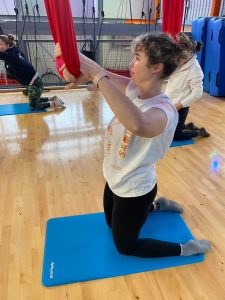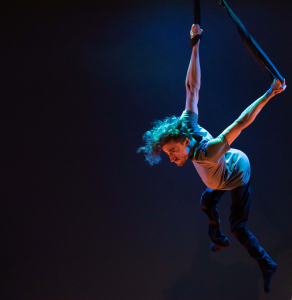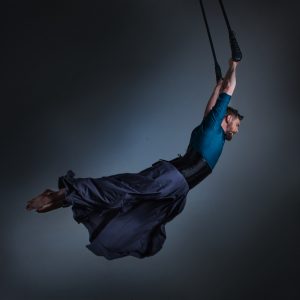I never imagined myself doing aerial again.
Journalist Meg Fozzard had never considered returning to her love of aerial performance since becoming disabled in 2019, but working with Diverse City changed all of that.
I was so nervous on the way to my first class that I thought I was going to be sick. As a wheelchair user and disbled person, trying new things (or things that you did years ago but thought were impossible now) can be very daunting. I was the only obviously disabled person in the room. I did my best during the warm up, with the instructor showing me how I could adapt the moves to suit my disabled body and my wheelchair. As we approached the aerial sling I had no idea how I was going to get on. It took a lot of effort from the instructor and my Mum, who is my carer. Now strength conditioning. I’m definitely much weaker than I used to be. The instructor showed me some moves, both with the sling open and closed. By the end I was drenched in sweat and my muscles would ache for a week. Just like the first time I did aerial, all those years ago. But some things came back instinctively, like remembering to point my toes.

I began doing aerial in early 2015. I’d moved back to my home city of Nottingham after university, and felt a little listless. Before Christmas, I had decided that I wasn’t going to give something up as a New Year’s resolution, I was going to take something up. I can’t remember now why I chose pole dancing, but I loved it – despite all the bruises that came with it. I was by no means the best in the class but I enjoyed watching my own progression and feeling my body get stronger. Classes were fun and I found it a great way of staying fit that didn’t feel like exercise. I’m not a dancer by nature, so I was always getting told to point my feet. The most nerve racking part was still going upside (called inverting in the aerial world).
When I moved to London in 2018, aerial took a bit of a back seat. I was studying again, which took up most of my time and money. Still, I managed to find a class and I switched from pole, which I felt out of practice doing, to aerial hoop. I loved this new format, maybe even more than pole. I liked being in the air. I was never close to professional or competition level, but that didn’t matter to me. I just really enjoyed it.
In April 2019, I suddenly and dramatically became disabled and my life changed completely. Before I was a relatively healthy 26 year old. Now, I have an ICD (Implantable cardioverter defibrillator) fitted for a previously unknown heart condition and I’m an ambulatory wheelchair user as a result of a brain injury. Circumstances of health can change so quickly, for anyone.When I became disabled in 2019 I deleted all the pictures of me doing aerial off of Instagram, but I still have the photos backed up on my laptop. Looking at them just made me too sad. If I can’t balance well enough to walk, how was I ever going to balance well enough to be high up in the air on a pole or aerial hoop? A cardiologist also warned me off the idea, on the off chance that I’d have a cardiac arrest again up in the air. A shock from my defibrillator would keep my heart going but I would lose consciousness and fall from whatever great height I was at.
In February 2022 I began working for Diverse City/Extraordinary Bodies. I’m a producer and journalist, and nowadays disability is a thread that runs through most of my work. I love working with companies that champion disabled people at the heart of what they do, so I was really happy to be offered the role of Outreach Coordinator ahead of the two shows that they had at Brighton Festival, Human and Till We Win.

Before working for Diverse City, I hadn’t really thought much about disabled people doing aerial.
My own experience with my doctors had scared me off ever trying again. I didn’t think it was possible. The next day, I saw both performances and was absolutely blown away. I had never seen disabled people doing aerial before. In Human, there was an aerialist [Johnny Leitch] who is a wheelchair user and he just seemed so strong and capable. Human is already a very personal show, with stories of growing up and lockdown, but it really personally resonated with me. I even welled up slightly during Human, thinking about how much I’d enjoyed aerial as a hobby and how much I’d missed it.. Afterwards my Mum told Becky, the Executive Director of Diverse City, that I’d loved doing aerial but I’d given it up when I became disabled. “Tell Billy (Alwen, Extraordinary Bodies Artistic Director)” she said. “He can get anyone up there”.
Then, Billy let me know about Flying Fantastic, an aerial fitness school with locations near where I live. With further encouragement from my Mum I signed up for a class.
Flying Fantastic even has a disabled instructor, Joel. He found aerial before he realised that he was disabled.
As a kid I couldn’t join in sports, and never did any kind of exercise or movement, but found myself yearning to try aerial – and fell in love. Aerial arts gave and still give me a sense of freedom and control over a body that doesn’t always want to cooperate. I have (among other things) complex pain conditions, and can dislocate a knee trying to get dressed – but in the air I am strong, I can be powerful and dynamic, sexy, slow and hypnotic or ugly and playful. I get to be what I want to portray
As a disabled coach, I believe that aerial is for everybody – a belief I’m happy to back up with actions. I’ve spent years working out how to break down moves, find out how things work, and how things work for a body whose needs are constantly changing. So I use that in my practice to help others on their own journey. I really love working with people to find out what they can do, sometimes adaptations need to be made to the apparatus, sometimes just to the move, oftentimes it will take a lot of work and figuring things out – but there is always a way to help someone fly if that’s their dream.

Since my first class at Flying Fantastic I’ve been trying all kinds of classes to find what is right for me. So far, I’ve tried aerial slings, bungee and aerial pilates. With all of them, I feel supported by the equipment or they are more floor based, so even if I were to have another cardiac arrest, I’m not going to get seriously hurt. It definitely takes a lot longer now for my body to recover. But, I’ve started posting about my journey doing aerial again on Instagram. Sometimes it feels like I’m back at the beginning and it can be frustrating, but it’s worth it to do the hobby I love again. If I hadn’t worked with Diverse City/Extraordinary Bodies, none of this would have felt possible. I still have my Extraordinary Bodies T-shirt that I was given in Brighton and sometimes I wear it to class. It says “Circus for every body” on it and I’m starting to believe that is true.
We all have a voice that says “I can’t”- whether you are disabled or non disabled. Next time, try to listen to it a little less.
She graduated in February 2019 and became disabled in April 2019, drastically altering her career. As an early career freelancer she works across different sectors, but the performing arts is the one she has found most fulfilling and accessible. She tries to work within the theme of disability across sectors. Her writing on disability rights issues and culture have been featured in Vice, BBC Ouch, Stylist, Refinery 29 and Wellcome Stories. You can see examples of her previous work and get in touch with her at her website.
Joel is an instructor at Flying Fantastic can be followed on Instagram @cirquejoel





